Volleyball drills for technique attack / smash / spike / hitting
- 2 rows behind the back line.
- First 2 stand in the field.
- Trainer brings in ball.
- Pass left player towards position 2/3 then setup of right player.
- The passer goes to attack on own side of the court.
- The setupper does attack coverage.
- The two teams rotate to form a new pair.
- Extension: There are now 2 attackers at the net.
- The rest do exactly the same as before.
- Attackers come back from the net after the coach has brought in the ball.
- The setup always goes to the opposite corner from the set-upper.
- Pass from the right back, then left back setup on the right front.
- Set-upper covers and takes the place of the attacker.
- The passer remains standing and so does the non-offending player.
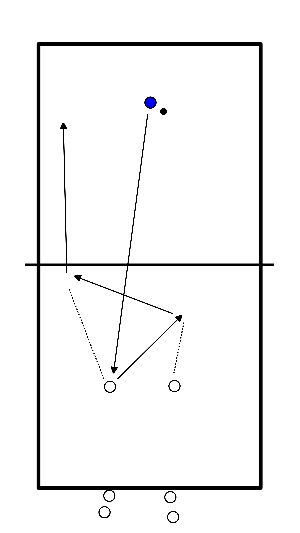
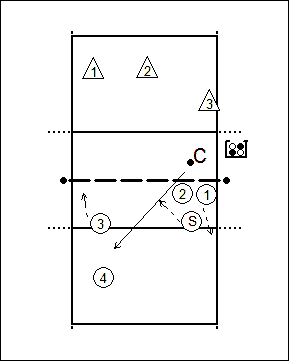
C attacks diagonally on 3 and 4- 1 and 2 after the block attack
3 and 4 defend, playmaker comes in
set-up to 1,2 or 3, attack to 3 defenders.
These defend for themselves and put the ball in the box.
- C throws a ball to A or B
- Set up a block on that side
- Pass the ball over the block to the defence
- Build up an attack on the middle
- Change after 10 balls
- Variation: attacking outside or behind
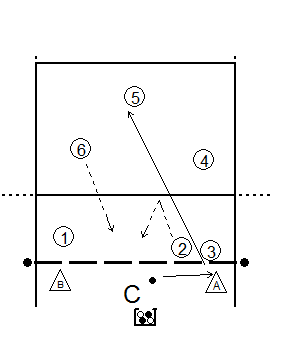
- 3x trio
- 2 threes play regular rally, also start with service.
- on the other side 3 players handle the service, and deliberately play a high underhand ball.
- team on the other side has to handle the ball by running well, the 2 outfielders have to go backwards, the passer calls loose, the midfielder calls high ball, and distributes the game.
- The 2 outfield players have already made a few steps to the back to assist with the high ball, and are thus ready to attack.
- 6 players on the opposite side of the field just play out the rally.
- On this side of the field the players are lined up on 2 and 4
- Trainer plays the ball up a few times in front of himself, so that the players do not know when it will come.
- They have to look good to be able to time the ball.
- Then the player attacks.
- In today's exercise, the following techniques will be used: serving, attacking, passing and distributing.
- However, the emphasis is on the pass and the distribution.
- The players have to watch, think well and react adequately during this exercise.
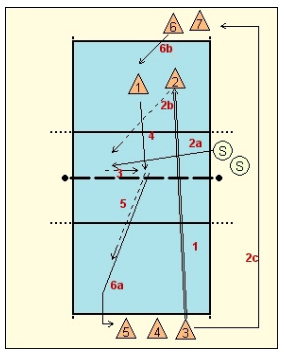 The diagram looks more complicated than the exercise is. The exercise goes as follows (I keep the numbering of the red numbers):
The diagram looks more complicated than the exercise is. The exercise goes as follows (I keep the numbering of the red numbers):
- 1 player 3 serves
- 2a one of the two playmakers runs to the position at the right front (the playmakers take turns)
- 2b one of the two passers (in this case player 2) passes the ball to the right front side
- 2c player 3 (who has just served) runs to the backline of the other half of the game
- 3 the server gives a setup to the player who did NOT pass. A setup to the centre if player 2 has passed and a setup to the outside if player 1 has passed.
- 4+5 the player who did not pass attacks (in this case player 1)
- 6a the attacker retrieves his own batted ball and joins the back of the line of serves.
- 6b the attacker's place is taken by the first player in the row behind the court.
As soon as the ball is struck the next service is executed.
- Group split into two groups of 5, field divided into two halves'.
- on each side a bench on the back line with cones on it. (opposite sides)
- 3 players leave on the back line, 1 reserve, 1 service on other side of the field.
- A serve is given to the three players: reception - pass - touch over net.
- when the player has played the ball the players walk to the side where the bench is: reception - pass - hit to the cones
- Which team hits the most cones off the bench?

- You stand about 3 meters from a wall, you do the attack run. (attack pass) Short-long- close pass (brake pass).
- If you get too close to the wall with the brake pass, you have to look at how big your 2 previous passes were.
- With the brake pass/ close pass you make sure your striking hand touches the wall (don't put too much force on it)
- You take your arms with you, so with the short arms to the front, with long arms to the back, with the brake pass bring your arms up.
- Pay attention:
- Make sure you don't end up too close to the wall.
- Or that you hit the wall with your face.
- Also keep an eye on your technique and how your feet end up.
- On one side you attack with three attackers, on the other side you defend.
- Trainer throws balls for the playmaker
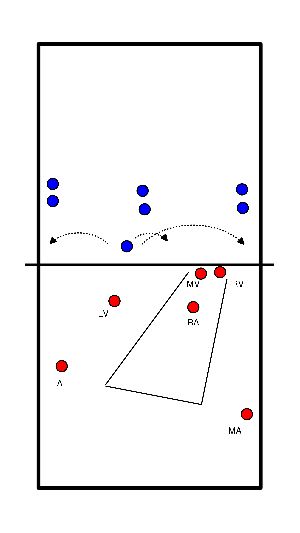
5 hoops distributed over the field:
- 1 in the corner at position 1
- 1 in the corner on position 5
- 1 in the corner on position 2
- 1 in the corner at position 4
- 1 on the 3 meter line - in the middle of the field
A on pass:
- Self-touching - A plays back - attacks/allies on returned ball
OR
A on pass:
- Passing to right post - someone on position 5: himself passes to A - A passes and attacks
At the centre: someone stays on to pass the ball to the centre
- Right: right big step, quick li/re connect for jump.
- Think about the arm movement.
- At the big step, arms forward; at the small step, arms backward to take up position (arching) and to smash.
Variation: throwing a tennis ball
Attacking pass, from pylon, right, front centre, back.
Players take in pairs 1 ball
Player A stands 2 foot lengths from the curtain.
Player B stands 1 meter behind player A
- Player B hits the curtain
- Player A must keep the ball off the ground
Goal:
- Standing low
- Stand ready
- Expecting the ball
- Do not go for your favourite side
- Roll over if you can







